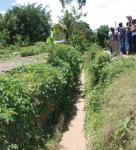USAID Restores Irrigation Systems in Plaine du Cul de Sac
 Haiti's long term development depends on agriculture. Yet most of Haiti's population relies on what could be called a faith based approach to agriculture - pray you get enough rain at the right time. Ressurecting Haiti's agricultural sector requires effective irrigation systems. Below is a description of an irrigation project that USAID completed with IOM and CHF in the Plaine de Cul de Sac outside of Port au Prince. The photo above illustrates what the waterways were like before the project...
Haiti's long term development depends on agriculture. Yet most of Haiti's population relies on what could be called a faith based approach to agriculture - pray you get enough rain at the right time. Ressurecting Haiti's agricultural sector requires effective irrigation systems. Below is a description of an irrigation project that USAID completed with IOM and CHF in the Plaine de Cul de Sac outside of Port au Prince. The photo above illustrates what the waterways were like before the project...
 ...and here is what they looked like after the project. When engineers tried to repair the fabled water system of Plaine du Cul de Sac, a vast farming valley near Port-au-Prince, the canals were covered in mud and debris buried by eroding soil from deforested mountains that haunt Haiti.
...and here is what they looked like after the project. When engineers tried to repair the fabled water system of Plaine du Cul de Sac, a vast farming valley near Port-au-Prince, the canals were covered in mud and debris buried by eroding soil from deforested mountains that haunt Haiti.
Silt and sediment covered the water system by more than three meters, according to engineer Jude Clercidor Martinez, working on a USAID-funded project. But a village elder remembered when the water flowed and indicated exactly where to find the buried canals. This irrigation system had been buried under three meters of silt and mud. USAID projects are helping to restore the productivity of Haiti’s land.
Water intake system that feeds the irrigation canals of Plaine du Cul de Sac. Water had last run freely sometime in the late 1940s or early 1950s according to the elder, who reckoned time not by a calendar but by who occupied the Haitian presidency. It was a bit before the first Duvalier, the elder said, referring to the much feared Papa Doc.
With the elder’s advice and with $800,000 in USAID financing, the amount of arable land in the Plaine du Cul de Sac has grown from 1,300 hectares to 4,000 hectares in less than a year, and as many as 30,000 farmers will now have the prospect for a better life.
Erosion, mud slides, blocked canals, and flooding abound in Haiti, especially during hurricane season. Poor people burn the trees off the hillsides to create farmland or to produce charcoal to sell to the city residents. With the roots gone, rains wash away the topsoil.
Because problems faced by farmers such as poverty and hunger impact the cities nearby, USAID’s strategy for the country is shifting, said Alex Deprez, the Agency’s acting deputy director in Haiti. We are moving from treating urban hotspots with projects that prioritize security and short-term job creation to creating zones of greater economic opportunity, he said.
This means treating urban and rural areas together as development challenges. The Plaine du Cul de Sac once was one of Haiti’s key breadbasket areas but has suffered considerably from soil degradation. Reviving agricultural production there is seen as critical to generating jobs and feeding a hungry country that was among the first to experience urban rioting during the food crisis last year.
Approximately 70 percent of Haiti’s 9 million people work the soil on land that was once so productive, its sugarcane plantations stirred the ambitions of imperial powers. But today it is cheaper to import sugar than to produce it locally.
Sixteen kilometers of primary canals and 46 kilometers of secondary canals are being refurbished in the Plaine du Cul de Sac by a USAID partnership with the International Organization of Migration and the Cooperative Housing Foundation, with the support of Saint-Ange Darius, mayor of Croix des Bouquets, a town located just outside Port-au-Prince.
Darius said the future of his town depends on those farmers: If they do not do well, it could result in a very restive city center. The mayor, the Ministry of Agriculture and Rural Development, and local users of the water resources are working together on the restoration.
Farther up from the plain, a system of sluices directs the water flow in seven directions to the canals. And farther up yet, rock gabion walls are under construction that will protect the irrigation system’s intake area at the periodically turbulent Gris River.
Similar engineering projects to control flooding and reclaim land on hillsides and in plains can be found in Gonaives, around Port-au-Prince, and elsewhere in Haiti. It is all part of a visionary scheme for the island that is working from ravine to reef to restore the productivity of Haiti’s land.
Add new comment